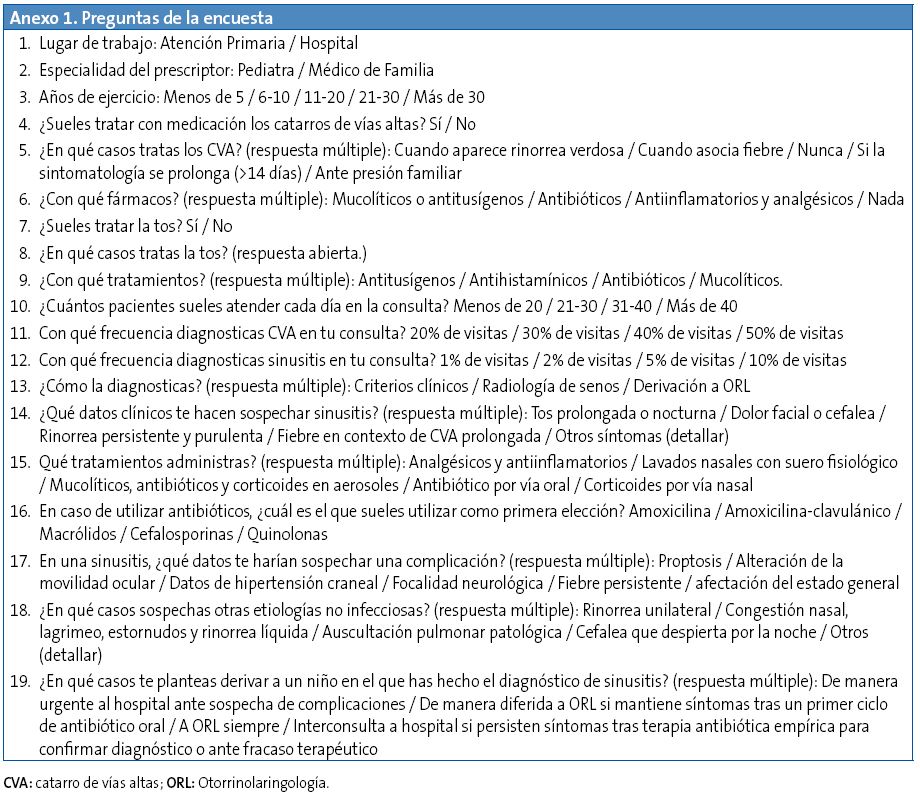Vol. 16 - Num. 61
Originales
Diagnóstico y manejo de la sinusitis: actitudes de los pediatras
M.ª Rosa Albañil Ballesterosa, C Calvob, P Hernando Helgueroc, L Martínez Camposd, Begoña Domínguez Aurrecoecheae
aPediatra. CS Cuzco. Fuenlabrada. Madrid. España.
bServicio de Pediatría. Hospital Universitario Severo Ochoa. Leganés. Madrid. España.
cPediatra. CS Ramón y Cajal. Alcorcón. Madrid. España.
dUGC Pediatría. Hospital La Inmaculada. Almería. España.
ePediatra. Instituto de Investigación Sanitaria del Principado de Asturias (ISPA). Asturias. España.
Correspondencia: MR Albañil. Correo electrónico: mralba100@hotmail.com
Cómo citar este artículo: Albañil Ballesteros MR, Calvo C, Hernando Helguero P, Martínez Campos L, Domínguez Aurrecoechea B. Diagnóstico y manejo de la sinusitis: actitudes de los pediatras. Rev Pediatr Aten Primaria. 2014;16:23-33.
Publicado en Internet: 14-04-2014 - Número de visitas: 40306
Resumen
Introducción: la sinusitis es una patología frecuente de la que desconocemos su abordaje en la práctica pediátrica diaria.
Material y métodos: se realiza un estudio trasversal, de ámbito nacional mediante una encuesta distribuida on-line a los socios de dos sociedades pediátricas en marzo de 2013.
Resultados: se obtuvieron 994 respuestas (78% de Atención Primaria). La mayoría de profesionales estima una frecuencia de sinusitis de alrededor del 1% de las visitas, el 76,6% refiere diagnosticarla exclusivamente con criterios clínicos, y el 92% considera una asociación de síntomas que incluyen rinorrea persistente/purulenta (89%), dolor facial/cefalea (84%), tos prolongada o nocturna y fiebre en el contexto de infección respiratoria de vías altas (IRA) 54%. El 19,7% de los profesionales de primaria y el 33,4% de los de especializada solicitarían un estudio radiológico. Un 90% refiere utilizar antibióticos con o sin otros tratamientos: amoxicilina-clavulánico (52%), seguido de amoxicilina 46% (relación que se invierte en Atención Primaria).
Un 81% de los pediatras refiere diagnosticar IRA en más del 30% de las visitas, y en el 85% de los casos no prescriben tratamiento farmacológico. Ante una sintomatología catarral prolongada más de 14 días, un 70% decidiría tratar. Los tratamientos más utilizados serían antiinflamatorios/analgésicos en el 54,5% de los casos, y antibióticos en el 51,4%.
Conclusiones: las respuestas de los pediatras sobre conocimientos y práctica clínica en IRA y sinusitis indican un alto nivel de adecuación a las Guías más recientes, destacando la escasa utilización de antibióticos en las IRA, el diagnóstico eminentemente clínico de la sinusitis y la elección empírica de antibióticos en la misma.
Palabras clave
● Amoxicilina ● Amoxicilina-clavulánico ● Antibióticos ● Infección respiratoria de vías altas ● Radiología ● SinusitisINTRODUCCIÓN
Se define sinusitis como la inflamación de uno o más senos paranasales1. Suele ser de etiología infecciosa y estar asociada a cuadros infecciosos virales de vías respiratorias altas (IRA), debido a la continuidad que existe entre la mucosa que recubre las fosas nasales y los senos. La segunda causa es la patología alérgica. Según la Academia Americana de Pediatría2, sinusitis aguda bacteriana es la infección bacteriana de los senos paranasales de duración inferior a 30 días, con resolución completa de los síntomas.
En los últimos dos años se han publicado varias Guías de Práctica Clínica que incluyen recomendaciones sobre el diagnóstico y tratamiento1,3-5, pero hay pocos estudios6-8 que permitan evaluar los conocimientos y actitudes de los profesionales, posiblemente por la variabilidad de los criterios diagnósticos y la ausencia de una prueba diagnóstica objetiva y de fácil realización.
Recientemente se ha elaborado un Documento de Consenso sobre etiología, diagnóstico y tratamiento de la sinusitis, en el que han colaborado la Sociedad Española de Infectología Pediátrica (SEIP), la Asociación Española de Pediatría de Atención Primaria (AEPap), la Sociedad Española de Pediatría Extrahospitalaria y Atención Primaria (SEPEAP) y la Sociedad de Otorrinolaringología (SEORL PCF)9, algunas de cuyas conclusiones fueron presentadas en el Congreso Nacional de la Asociación Española de Pediatría (AEP). Antes de la difusión del Consenso, se consideró de interés conocer la práctica clínica de los pediatras españoles con respecto a esta patología.
MATERIAL Y MÉTODOS
Se realizó un estudio transversal, multicéntrico, de ámbito nacional, mediante una encuesta on-line diseñada al efecto, dirigida a pediatras y distribuida a través del correo electrónico a los socios de dos sociedades pediátricas (AEP y AEPap) y de una lista de correo, PEDIAP. Se diseñó según tecnología de Google Docs®. Las preguntas de la misma (Anexo 1) van dirigidas a explorar los conocimientos y actitudes de los pediatras españoles sobre los catarros de vías altas (frecuencia, síntomas y tratamiento de los mismos) y sobre la sinusitis (frecuencia, síntomas, diagnóstico, tratamiento y complicaciones de la misma). Algunas preguntas tienen una sola respuesta, la mayoría son de respuesta múltiple y una de ellas es abierta. En la información preliminar de la encuesta, se advierte que solo deben contestarla aquellos profesionales que atiendan sinusitis en su ámbito profesional habitual. Se recogieron además las siguientes variables: lugar de trabajo, especialidad, años de ejercicio y pacientes atendidos al día. La respuesta fue anónima y voluntaria.
La encuesta se distribuyó en marzo de 2013. En esa fecha, el número de socios de la AEP era 9036, de los que 6215 eran pediatras de Atención Primaria (AP). El número de socios de la AEPap era de 3287, la inmensa mayoría de los cuales trabajan en AP. Los socios de la AEPap pueden serlo también de la AEP. La población diana a la que se dirigió la encuesta eran los 6215 pediatras de AP, más un pequeño porcentaje de los pediatras hospitalarios que atienden sinusitis en su práctica clínica. Probablemente no superan en total los 7000. Tomando como referencia otros estudios realizados mediante encuestas en nuestro ámbito10, hemos considerado que el tamaño muestral necesario para poder estimar las actitudes de los pediatras respecto a las IRA y la sinusitis, con un error menor del 5%, un nivel de heterogeneidad del 50% y un intervalo de confianza del 95% (IC 95%), suponiendo nuestra población diana de pediatras de 7000, es de 365 respuestas.
Dado que no se incluyen datos de pacientes y las respuestas han sido anónimas y voluntarias, no se ha considerado necesario la aprobación por un Comité de Ética. Las autoras del estudio han sido las únicas que han tenido acceso a los resultados, recogidos exclusivamente con fines estadísticos.
RESULTADOS
Se obtuvieron 994 respuestas. El 98% procede de pediatras (el 2% restante pertenece a médicos de familia o médicos generales), el 78% de los cuales ejerce en AP. El 77% con un tiempo de ejercicio profesional superior a diez años, y alrededor de la mitad superior a 20 años. Casi el 50% atiende entre 20 y 30 pacientes cada día y el 73% entre 20 y 40 (Tabla 1).
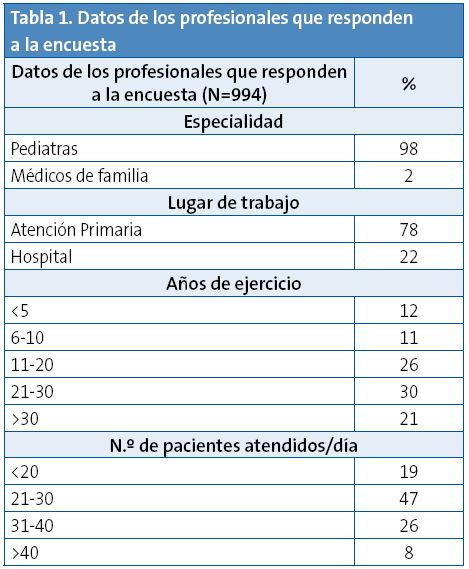
Un 81% de los pediatras refiere diagnosticar IRA en más del 30% de las visitas que atiende, y mayoritariamente (85%) no prescribir tratamiento farmacológico en este proceso (Tabla 2). Sin embargo, cuando la sintomatología catarral se prolonga durante más de 14 días, con o sin otros síntomas asociados, hasta el 70% de los pediatras decidiría tratar (Fig. 1). Los tratamientos más utilizados serían antiinflamatorios o analgésicos, solos o asociados a otros fármacos, por un 54,5% de los médicos, y antibióticos solos o asociados, por un 24 y un 51%, respectivamente, de los encuestados (Fig. 2).

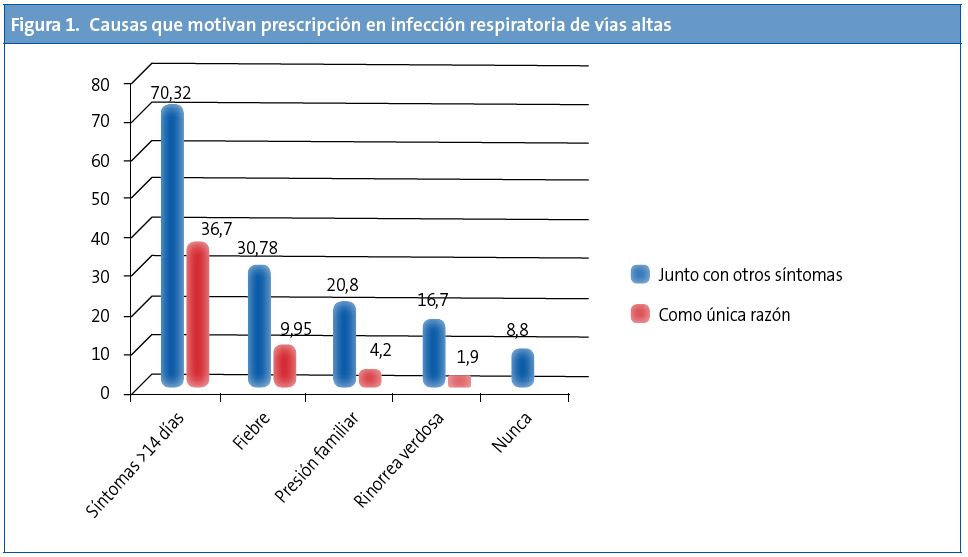
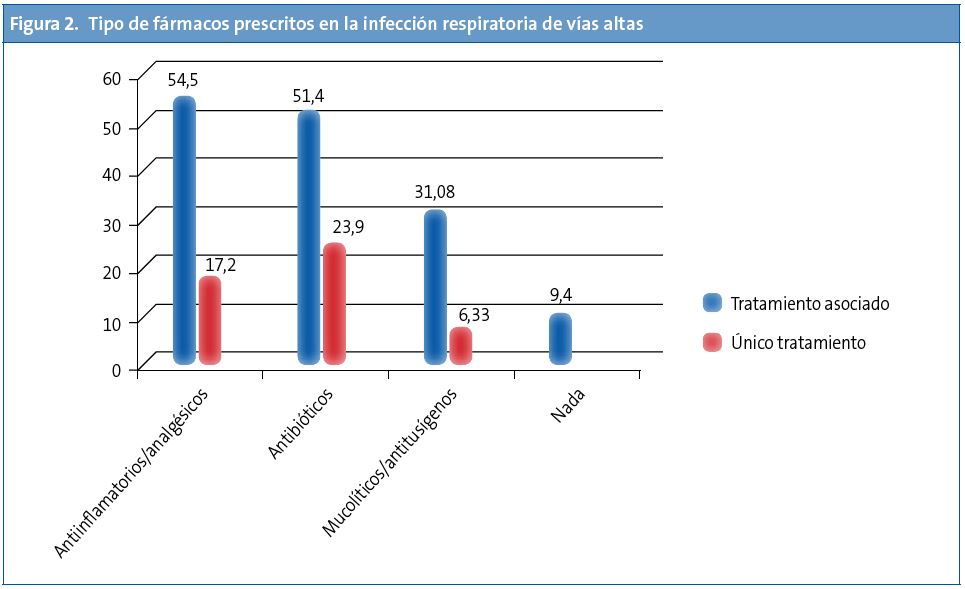
Sinusitis
Una mayoría de pediatras, el 69%, diagnostica sinusitis en un 1% de las visitas que atiende (Tabla 2). Más del 92% lo hace con una combinación de síntomas, de los cuales los que se tienen en cuenta con más frecuencia son la rinorrea persistente o purulenta (89,5%) y el dolor facial/cefalea (84,6%). La tos prolongada o nocturna y la fiebre en el contexto de IRA son tenidas en cuenta por el 54% de los pediatras (Fig. 3).
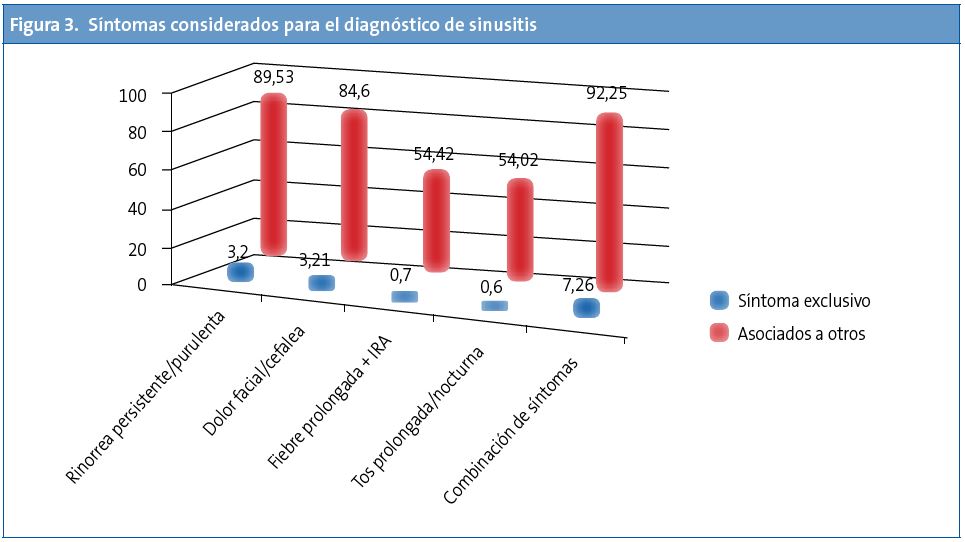
El 76,6% de los encuestados (el 79,71% de los pediatras de AP y el 65,58% de los de especializada) refiere realizar el diagnóstico exclusivamente por criterios clínicos, mientras que la radiología, sola o conjuntamente con otros recursos, es utilizada por el 22,7% (el 19,76% de los pediatras de AP, frente al 33,48% de los de especializada). El 1% deriva a Otorrinolaringología (ORL) (Fig. 4).
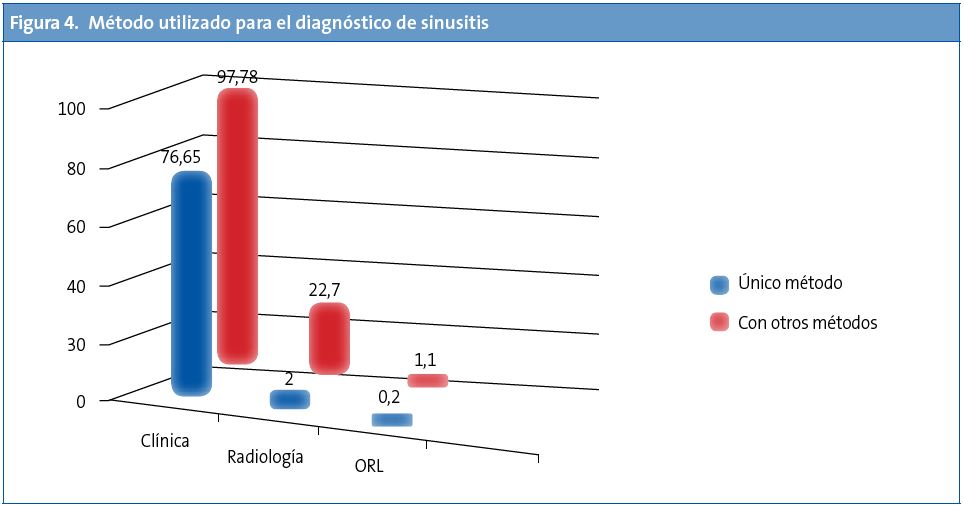
En cuanto al tratamiento, un 78,26% de encuestados prescribiría dos o más fármacos. Un 90% utilizaría antibióticos, solos o junto con otros fármacos (el 18% como único tratamiento) (Fig. 5), siendo amoxicilina-clavulánico es el más utilizado (52%), seguido por amoxicilina, por el 46% de los encuestados (Fig. 6). La elección de amoxicilina es más frecuente en los pediatras de AP (50,57%) que entre los de especializada (30,23%), mientras que amoxicilina-clavulánico es más elegida en atención especializada (68,37%) que en AP (47,24%). Otros tratamientos prescritos son lavados nasales con suero salino (59%), antiinflamatorios/analgésicos (55,5%) y corticoides nasales (29%). El 11% recomienda la medicación en aerosol (Fig. 5).
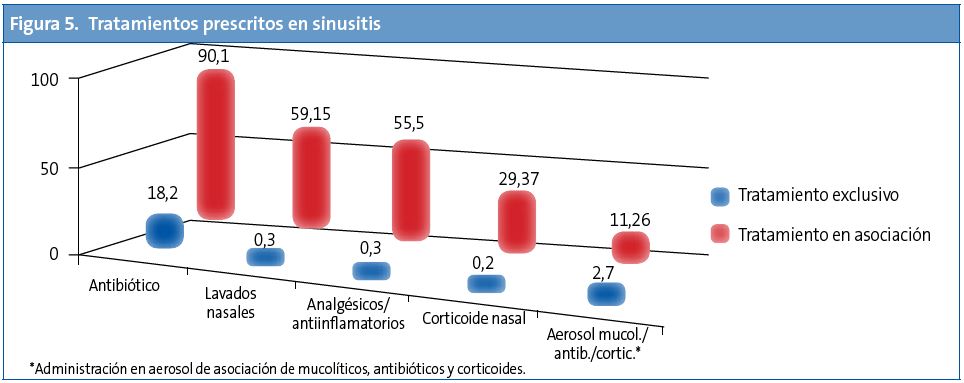
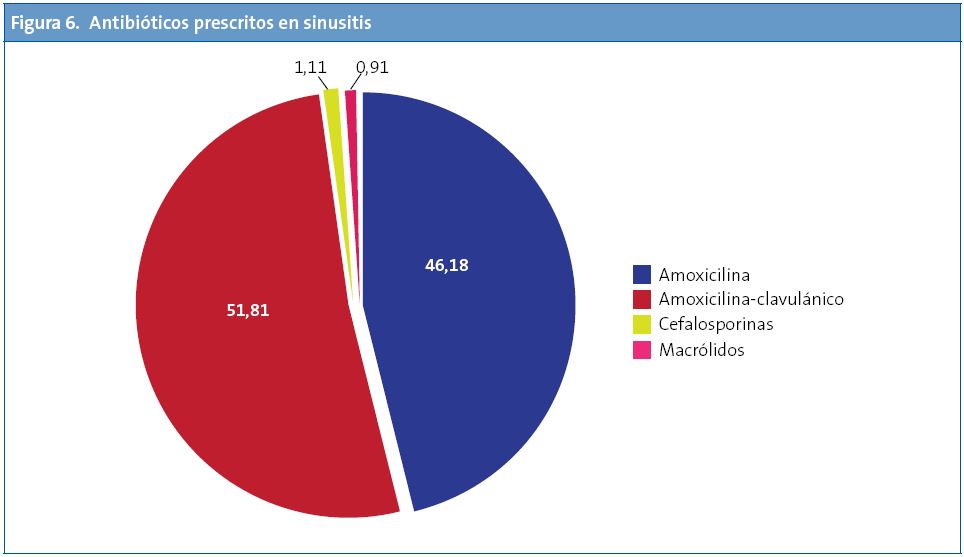
Se sospecha existencia de complicaciones ante la persistencia de fiebre y mal estado general (92,75%), alteración de la movilidad ocular (79,47%), proptosis (79,37%), focalidad neurológica (72,54%) y datos de hipertensión intracraneal (61,46%).
La derivación se realiza al hospital de manera urgente ante la sospecha de complicaciones (70,72%) o de forma diferida ante fracaso terapéutico, a ORL (34,40) o al hospital (29,27%). Solo un 0,5% deriva siempre a ORL.
Los síntomas que se refieren como sugestivos de etiología no infecciosa son rinorrea unilateral (81,2%), congestión nasal, lagrimeo, estornudos y rinorrea líquida (75%), cefalea que despierta por la noche (71,8%) y auscultación pulmonar patológica (51,7%).
DISCUSIÓN
Presentamos los resultados de una encuesta de ámbito nacional realizada fundamentalmente entre pediatras de AP, en la que se objetiva que, ante una sintomatología catarral prolongada más de 14 días, el 70% de los pediatras refiere prescribir tratamiento farmacológico. El diagnóstico de sinusitis se sospecha en alrededor del 1% de las visitas, y en un 76,6% de los casos se diagnostica exclusivamente con criterios clínicos. Se indicaría antibiótico casi en el 90% de los casos, acompañado o no de otros tratamientos coadyuvantes. El antibiótico más utilizado es amoxicilina-clavulánico. Aunque con algunas desviaciones, estos datos muestran una alta adecuación a las Guías de Práctica Clínica más recientes1,3,4,9.
Es difícil conocer la frecuencia de sinusitis por varias razones. Respecto a la definición del proceso, según la Clasificación Internacional de Atención Primaria (CIAP) (incluida en los programas informáticos utilizados en muchas comunidades autónomas) se trata de “secreción nasal/retronasal purulenta o episodios previos de sinusitis, más aumento de la sensibilidad a la presión/inflamación de uno/varios senos o dolor facial profundo agravado en determinadas posiciones de la cabeza o pus obtenido por punción sinusal o demostración radiológica o bien opacificación en transiluminación”. Este concepto contrasta claramente con las recomendaciones más recientes en cuanto a diagnóstico y utilización de pruebas complementarias e incorporadas en buena parte a la práctica diaria. El segundo problema es la existencia de un registro inadecuado en las historias, dado que a veces se registran síntomas, como rinorrea, rinorrea prolongada o tos prolongada, y no procesos, o bien se conserva el primer diagnóstico, por ejemplo, infección respiratoria aguda, aun cuando se considere que, por la evolución del cuadro, ya estemos ante otra entidad. Nos pareció de interés iniciar la encuesta sobre manejo de la sinusitis con datos relativos a IRA, al estar ambos procesos íntimamente relacionados entre sí, de modo que en la mayoría de los casos los síntomas son comunes a ambos y solo se diferencian por criterios de duración e intensidad.
Se estima que los niños presentan de seis a ocho infecciones virales del tracto respiratorio superior al año, de las cuales entre el 5 y el 13%2 pueden complicarse con una sobreinfección bacteriana de los senos paranasales. Así, se comunican sinusitis en el 6,5% de las IRA en niños sanos de uno a diez años de edad11 y en el 8% de los niños de 6 a 35 meses de edad, siendo máxima la incidencia (10%) en el segundo año12. En EE. UU. se refieren tasas anuales de entre 11 y 14 consultas por sinusitis por cada 1000 menores de 18 años de edad, 13 en el grupo de 0 a 5 años, 9 en el de 6 a 11 años y 15 en el de 12 a 17 años7, y en Europa, de 2 a 18 por 1000 en el grupo de 0 a 17 años, con menor incidencia en el grupo de menor edad5. Según los datos de la encuesta, la mayoría de los pediatras (el 90%) atiende 10-20 casos de sinusitis por cada 1000 visitas (el 69% diez casos), cifra bastante acorde con las anteriormente citadas y con la referida en un estudio de morbilidad realizado en consultas de Pediatría de AP en Asturias, donde se registra sinusitis en el 2,1% de los episodios respiratorios que, a su vez, constituyen el 44,8% de todos los registrados13.
Actualmente, la recomendación de todas las Guías de Práctica Clínica1,3-5 y del Documento de Consenso nacional9, recientemente publicado, en cuanto al diagnóstico de sinusitis es que este debe realizarse en función de criterios clínicos en tres situaciones: cuando la sintomatología catarral persiste sin mejoría más de diez días, cuando empeora tras 6-7 días tras mejoría inicial, o si se inicia de forma inhabitualmente intensa con fiebre y rinorrea purulenta que duran más de 3-4 días. Los síntomas capitales que se tienen en cuenta para el diagnóstico de la sinusitis son rinorrea y tos en el primer supuesto, y rinorrea, tos y reaparición de fiebre en el segundo. Y estos mismos síntomas, agrupados en distintas combinaciones, son los referidos en nuestra encuesta: los citados con más frecuencia son rinorrea persistente/purulenta (89%) y dolor facial/cefalea (84%). Son muy pocos los pediatras (7,7%) que citan un solo síntoma de sospecha para el diagnóstico de sinusitis. En este sentido, cabe señalar que, si bien la cefalea podría ser el único síntoma en algunos pacientes (esfenoiditis), tanto la cefalea como el dolor facial aislados sin otros síntomas no suelen ser datos de sinusitis14. En otro estudio realizado mediante encuesta on-line a pediatras de EE. UU., si bien no puede realizarse una comparación exacta con nuestros datos porque en él las opciones para responder presentan una categorización distinta, el dato clínico considerado más frecuentemente como muy importante es la persistencia de los síntomas, para un 93% de ellos, seguido por rinorrea purulenta para un 55%, congestión nasal para el 43%, y cefalea y tos nocturna para el 32 y el 29%, respectivamente6. Para el 95% de los pediatras era menos probable realizar el diagnóstico si los síntomas estaban mejorando. Este concepto de mejoría, o de ausencia de ella, es considerado por las Guías como muy importante a la hora de realizar el diagnóstico de infección bacteriana4.
Según nuestra encuesta, solo 22% de los pediatras realizaría estudio radiológico para el diagnóstico, más en especializada que en primaria, dato que se ajusta a la recomendación de no realizar estudios radiológicos en sinusitis no complicada, no grave, no recurrente y en pacientes sin enfermedad de base15 asumida actualmente por todas las Guías de Práctica Clínica1,3-5 y por el Documento de Consenso nacional9 y que contrasta con los del estudio estadounidense antes referido, en el que más de la mitad (58%) de los pediatras consultados refiere solicitar, al menos ocasionalmente, una tomografía computarizada o una radiología de senos (40%), y el 70% de ellos, una de las dos exploraciones radiológicas para el diagnóstico de sinusitis no grave6.
En nuestra encuesta, los pediatras refieren prescribir antibióticos en el 90% de casos, en el 18% como único tratamiento, cifra acorde con las publicadas previamente (82 y 92%) y referidos a consultas de AP y Servicios de Urgencia Hospitalaria7,16 y tanto con datos recogidos a partir de historias (82%)7 como en el estudio on-line, en el que un 95% dice tratar frecuente o muy frecuentemente6.
La prescripción de antibióticos para el tratamiento de la sinusitis es una práctica generalizada aunque debatida, por tratarse de una patología autolimitada con altas tasas de resolución espontánea17. Hay pocos estudios que comparen resultados entre la administración de placebo o antibiótico11,18-20. Incluyen, además, un pequeño número de casos y tanto los criterios de inclusión, es decir, la definición de caso, como los criterios de mejoría y/o curación y el tipo y dosis de antibiótico utilizados no son homogéneos. Existen dos metaanálisis que concluyen que en niños con sinusitis aguda el tratamiento antibiótico en las dosis estudiadas no aporta beneficio21, mientras que el segundo concluye que el beneficio que aporta, con una odds ratio de 2 (IC 95% 1,16 a 3,47), no está basado en una evidencia sólida, y que se deben mejorar el diagnóstico y los criterios de inclusión22.
En cuanto al antibiótico utilizado, se describe en la literatura un porcentaje importante de inadecuación, en un 42% de las visitas en consultas8 y en un 22% en Servicios de Urgencia Hospitalaria pediátricos16. Mientras las Guías recomiendan como primera elección amoxicilina o amoxicilina-clavulánico y desaconsejan o admiten con muchas reservas y en casos muy seleccionados el uso de macrólidos9, se registra una utilización de los mismos hasta en un 18% de los casos, dato no justificado por las cifras de alergia a la penicilina. Cabe señalar que, frente a estos datos publicados, la intención de prescribir referida en nuestra encuesta se ajusta casi de forma absoluta a las recomendaciones, al corresponderse con amoxicilina y amoxicilina-clavulánico y ser mínima la prescripción de cefalosporinas y macrólidos, y nula la de quinolonas. Estas cifras son similares a las obtenidas en la encuesta estadounidense6. Quizás el uso de amoxicilina-clavulánico excede las recomendaciones, al menos en referencia al Documento de Consenso nacional9.
La solicitud de estudio radiológico más frecuente, así como el mayor uso de amoxicilina-clavulánico, referido en especializada podría relacionarse con la atención, en este nivel, de pacientes con mala evolución, en los que ha fracasado un primer ciclo de tratamiento o con sospecha de complicaciones.
En cuanto a otros tratamientos, los más usados serían, junto con antiinflamatorios y analgésicos, suero fisiológico para lavados nasales (60%) y corticoides por vía nasal (30%), que son los que parecen demostrar cierta utilidad según la bibliografía reciente23,24. Cabe destacar también que se muestra por parte de los encuestados un buen conocimiento tanto de los síntomas que hacen sospechar complicaciones, circunstancia que determinaría la derivación urgente al hospital, como de los que harían sospechar etiología no infecciosa.
Tiene interés resaltar la influencia que ante la decisión diagnóstica y terapéutica de los pediatras tiene la opinión de los padres, y que se pone de manifiesto, tanto en nuestra encuesta, donde un 4% admite tratar las IRA con fármacos por la presión familiar y casi un 21% lo tiene en cuenta, como en la encuesta estadounidense, donde un 13% admite que fue más proclive a diagnosticar sinusitis si creía que los padres esperaban el diagnóstico, y un 16% a tratar con antibióticos si pensaba que los padres esperaban dicho tratamiento6.
Este estudio tiene algunas limitaciones. En primer lugar, se trata de una encuesta, es decir, no refleja la realidad de la práctica clínica sino opiniones teóricas acerca de la misma, con respuestas que suponen una estimación subjetiva del profesional sobre la realidad de su práctica; las preguntas no se ajustan a escenarios clínicos concretos sino que son preguntas acerca de la práctica en términos generales. En segundo lugar, el número de respuestas que hemos obtenido es relativamente alto, aunque no podemos asegurar la representatividad de la muestra respecto a la población general de pediatras de nuestro país. En España contamos con una experiencia muy reciente, el estudio ABES10, donde se recibieron 1214 respuestas y cuyo universo era más amplio, pues estaba dirigido a todos los pediatras españoles, de cualquier especialidad, miembros de la AEP, más de 9000 en ese momento, mientras que nuestra encuesta solo va dirigida a los que atienden estos procesos. Teniendo en cuenta que de 9036 pediatras socios de la AEP, 6215 son pediatras de AP, nivel en el que se atiende mayoritariamente esta patología, la proporción de respuestas es superior a la obtenida en el estudio ABES10. Puede existir un sesgo determinado por las características del estudio y que los pediatras que contesten sean profesionales habituados a compartir experiencias y opiniones con otros compañeros, por lo que pertenecen a listas de correo y pueden estar más motivados, no solo para contestar la encuesta sino también para actualizar sus conocimientos.
En resumen, podemos concluir que la encuesta dirigida a pediatras españoles acerca de sus conocimientos y su práctica clínica en dos procesos, IRA y sinusitis, indica un nivel muy alto de adecuación a las Guías de Práctica Clínica más recientes y al Documento de Consenso nacional que ha sido publicado con posterioridad, destacando el escaso tratamiento antibiótico prescrito en las IRA, el diagnóstico clínico y no radiológico de la sinusitis y el tipo de antibióticos elegido en la misma. No obstante, pensamos que la reciente publicación del Consenso podría tener un impacto aún mayor en la mejora de la adecuación diagnóstica y terapéutica de los pacientes con sinusitis en la práctica clínica, lo que podría y debería ser explorado en un futuro próximo.
AGRADECIMIENTOS
A las Juntas Directivas de la AEP y la AEPap, por facilitar la distribución de la encuesta a sus socios, y a todos los compañeros que tuvieron la amabilidad de contestarla.
CONFLICTO DE INTERESES
Los autores declaran no presentar conflictos de intereses en relación con la preparación y publicación de este artículo.
ABREVIATURAS:AEP: Asociación Española de Pediatría • AEPap: Asociación Española de Pediatría de Atención Primaria • AP: Atención Primaria • IC 95%: intervalo de confianza del 95% • IRA: infección respiratoria de vías altas • ORL: Otorrinolaringología.
BIBLIOGRAFÍA
- Callén Blecua M, Garmendia Iglesias MA. Sinusitis. El Pediatra de Atención Primaria y la sinusitis. Protocolos del GVR (publicación P-GVR-7) [en línea] [consultado el 31/07/2013]. Disponible en http://aepap.org/grupos/grupo-de-viasrespiratorias
- American Academy of Pediatrics. Clinical Practice Guideline: Management of Sinusitis. Pediatrics. 2001;108:798-808.
- Chow AW, Benninger MS, Brook I, Brozek JL, Goldstein EJ, Hicks LA, et al. Infectious Diseases Society of America. IDSA clinical practice guideline for acute bacterial rhinosinusitis in children and adults. Clin Infect Dis. 2012;54:e72-e112.
- Wald E, Applegate K, Bordley C, Darrow D, Glode M, Marcy S, et al. Clinical Practice Guideline for the Diagnosis and Management of Acute Bacterial Sinusitis in Children Aged 1 to 18 Years Pediatrics. 2013;132:e262-e280.
- Fokkens WJ, Lund VJ, Mullol J, Bachert C, Alobid I, Baroody F, et al. European position paper on rhinosinusitis and nasal polyps 2012. Rhinology. 2012;50 (Supl 23):1-298.
- McQuillan L, Crane LA, Kempe A. Diagnosis and management of acute sinusitis by pediatricians. Pediatrics. 2009;123:e193-8.
- Shapiro D, Gonzales R, Cabana M, Hersh A. National Trends in visit Rates and Antibiotic Prescribing for children With Acute Sinusitis. Pediatrics. 2011;127:28-34.
- Cox E, Saluja S. Criteria-Based Diagnosis and Antibiotic Overuse for Upper Respiratory Infections. Ambulatory Pediatr. 2008;8:250-4.
- Martínez Campos L, Albañil Ballesteros R, de la Flor Bru J, Piñeiro Pérez R, Cervera J, Baquero Artigao F, et al. Documento de consenso sobre etiología, diagnóstico y tratamiento de la sinusitis. Rev Pediatr Aten Primaria. 2013;15:203-18.
- Piñeiro Pérez R, Calvo Rey C, Medina Claros AF, Bravo Acuña J, Cabrera García L, Fernández-Llamazares CM, et al. Uso empírico de antibióticos en niños en España. Resultados de una Encuesta Pediátrica Nacional 2012 (Estudio ABES). An Pediatr (Barc). 2013;79:32-41.
- Wald E, Nash D, Eickhoff J. Effectiviness of amoxicillin/clavulanate potassium in the treatment of acute bacterial sinusitis in chidren. Pediatrics. 2009;124:9-15.
- Revai K, Dobbs LA, Nair S, Patel JA, Grady JJ, Chonmaitree T. Incidence of acute otitis media and sinusitis complicating upper respiratory tract infection: the effect of age. Pediatrics. 2007;119:e1408-e1412.
- Domínguez Aurrecoechea B, Martín Rodríguez D, García Mozo R. Morbilidad en Pediatría de Atención Primaria en Asturias. Rev Pediatr Aten Primaria. 2006;8:21-37.
- National Institute for Health and Clinical Excellence. Clinical Knowledge Summaries. Sinusitis. Additional information [en línea] [consultado el 26/06/2013]. Disponible en http://cks.nice.org.uk/sinusitis#!diagnosissub
- American College of Radiology. ACR Appropiateness Criteria sinusitis Children. Última revisión 2012 [en línea] [consultado el 26/06/2013]. Disponible en www.acr.org/~/media/485AEEC108E941C6B5551A8D21017EED.pdf
- Ochoa C, Inglada L, Eiros JM, Solís G, Vallano A, Guerra L. Appropriateness of antibiotic prescriptions in community-acquired acute pediatric respiratory infections in Spanish emergency rooms. Pediatr Infect Dis J. 2001;20:751-8.
- Acute Bacterial Sinusitis Guideline Team, Cincinnatti Children’s Hospital Medical Center: Evidence-Based Care Guideline for medical management of Acute Bacterial Sinusitis in children 1 through 17 years of age [en línea]. Disponible en www.cincinnatichildrens.org/workarea/linkit.aspx?linkidentifier=id&itemid=87964&libid=87652
- Wald ER, Chiponis D, Ledesma-Medina J. Comparative effectiveness of amoxicillin and amoxicillin-clavulanate potassium in acute paranasal sinus infections in children: a double-blind, placebo-controlled trial. Pediatrics. 1986;77:795-800.
- Garbutt JM, Goldstein M, Gellman E, Shannon W, Littenberg B. A randomized, placebo-controlled trial of antimicrobial treatment for children with clinically diagnosed acute sinusitis. Pediatrics. 2001;107:619-5.
- Kristo A, Uhari M, Luotonen J, Ilkko E, Koivunen P, Alho OP. Cefuroxime axetil versus placebo for children with acute respiratory infection and imaging evidence of sinusitis: a randomized, controlled trial. Acta Paediatr. 2005;94:1208-13.
- Guarch Ibáñez B, Buñuel Álvarez JC, López Bermejo A, Mayol Canals L. El papel de la antibioterapia en la sinusitis aguda: revisión sistemática y metaanálisis. An Pediatr (Barc). 2011;74:154-60.
- Cronin MJ, Khan S, Saeed S. The role of antibiotics in the treatment of acute rhinosinusitis in children: a systematic review. Arch Dis Child. 2013;98:299-303.
- Kassel JC, King D, Spurling GK. Saline nasal irrigation for acute upper respiratory tract infections. Cochrane Database Syst Rev. 2010;3:CD00682.
- Zalmanovici A, Yaphe J. Intranasal steroids for acute sinusitis. Cochrane Database Syst Rev. 2011;4:CD005149.
